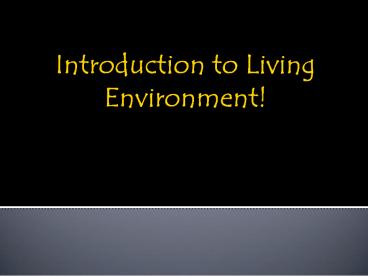Introduction to Living Environment! - PowerPoint PPT Presentation
1 / 18
Title:
Introduction to Living Environment!
Description:
When heating a material in a test tube: ... Incubator- keeps specimens warm (premature babies, cell samples) can be used to separate out cell parts ... – PowerPoint PPT presentation
Number of Views:89
Avg rating:3.0/5.0
Title: Introduction to Living Environment!
1
Introduction to Living Environment!
2
What is Science?
- It is the body of knowledge and the way of
knowing things - What is the difference between English as a body
of language and Science? - How do we know things?
3
Living Environment
- Aka Biology
- The study of living things in the environment
- What kind of things?
4
The Laboratory
- Always wear goggles when using chemicals.
- When heating a material in a test tube
- point tube away from you
- never put a stopper in the tube
- glassware
test tube
beaker
Graduated cylinder- always read volume at
meniscus
flasks
5
- Lab Safety Rap
- Current EVENTS- Lab Safety
6
DO NOW
- 1. What is the difference between a flask and a
beaker? - 2. What is a meniscus?
- 3. Why is lab safety so important?
7
Laboratory equipment
- Centrifuge/ultracentrifuge-
- machine that spins specimens at high speeds which
separates the materials w/in the specimen
according to density
- heaviest materials settle to the bottom
- can be used to separate out cell parts
- (nucleus from ribosomes)
- Micro-dissection Instruments-
- surgical instruments that cut apart microscopic
things - (ex. removing a nucleus from a cell)
Incubator-
- keeps specimens warm (premature babies, cell
samples)
8
Chromatography-
- chrom color
- process in which a substance (ink, chlorophyll)
is separated into its component parts/colors
- The rate at which the components move/separate
are unique to the substance being tested
- By comparing the separation of the unknown
substances to that of a known substance, an
identification may be made.
9
Triple Beam Balance
- Measures in grams
- Mass is different than weight!
Ruler
- Remember to use the metric (cm) side of the
ruler, not the inches side! 1 cm 10 mm
10
Gel Electrophoresis
- Used in crime investigation, paternity testing
and genetic research
11
How do we study Science?
- Define the problem/ question
- Hypothesis to explain
- Test with a controlled experiment
- Generate data to form inferences and conclusions
12
Conducting an Experiment
- A question you are trying to answer or problem
- you want to investigate
- A control the setup that remains the same
through the experiment provides a comparison
13
- A variable-
the element/factor that changes in the experiment
(amount of sun, water)
-a valid experiment tests only ONE variable
at a time
variable that does not depend on a factor in the
experiment (ex. time, days)
- independent-
relies on the independent variable ex) plant
growth depends on time, time does not depend on
plant growth
- dependent-
- A hypothesis-
possible answer to the question you are asking
often posed as an ifthen statement
14
- An observation-
what you see happening provides data for analysis
- A conclusion-
Sums up the findings. Scientists use the data to
determine whether the hypothesis was supported or
refuted
- Sample size-
Refers to the of organisms being tested. The
larger the sample size, the more valid the
results are.
15
What factors make a good experiment?
- Variables
- Control
- Large sample size
- Repeating the experiment with the same results as
were previous found- what does this do?
16
Measurements
- Length
- Mass
- Volume
- Temperature
- km, cm, mm
- Grams
- Liters, milliliters
- Celsius, Kelvin
- Have the same scale
- Celsius is based on where water freezes (0 C)
and boils (100 C) - Kelvin is based on absolute zero
17
(No Transcript)
18
Graphing Basics
- Scientists record lab observations and
measurements in an orderly manner - Using data tables and line graphs (sometimes bar
graphs too!) - Line graphs are used to show relationships
between two variables. - independent variable- horizontal, or x-axis
- Dependent variable- vertical, or y-axis































